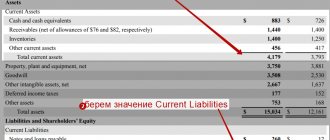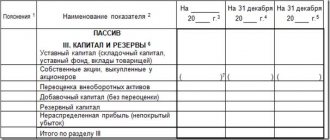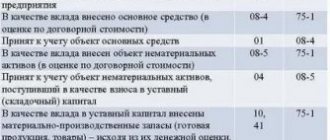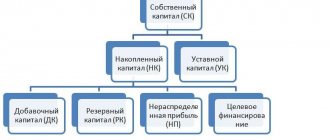Net working capital is an indicator that demonstrates the presence of liquid assets in a company and is used to analyze the financial viability of a company. From an economist's point of view, net working capital and own working capital – similar concepts and, being a characteristic of capital, often mean the same thing (at least, the Anglo-American financial institution draws an analogy between these two terms). Let's find out how to find net working capital and talk about the features of this indicator and its significance in the life of the company.
Net working capital on balance sheet
This capital represents part of the current assets, financed from its own or equivalent borrowed resources. It is not without reason that financiers call this capital a safety net, since its presence often saves an enterprise when the need arises to urgently repay short-term obligations and continue work, even in a reduced volume.
It is impossible to see the actual value of this indicator in the balance sheet, since the amount of net working capital is calculated, and several balance sheet values serve as the basis for it.
When calculating the amount of net capital, it is necessary to remember that short-term liabilities (CL) (for example, bank loans) are not taken into account in their composition, since part of the net capital is most often used to repay them. This difference will be the size of net assets that determine the level of financial solvency of the company, and the formula will be as follows:
Net working capital = Current assets (OA) – Short-term liabilities (KP)
Using balance sheet data for analytical activities
Based on the information presented in the second section of the reporting document, specialists have the opportunity to calculate various ratios used to assess the financial condition of the company. These include, in particular:
- Working capital mobility coefficient – balance sheet formula:
Coefficient = (Page 1240 + Page 1250) / Page 1200
- Own working capital – balance sheet formula:
Own working capital = Page 1200 – Page 1500
- Average value of current assets on the balance sheet. This indicator is determined by comparing the working capital values at the end of two reporting periods. Accordingly, for the calculation you will need:
Average asset turnover = (Line 1200Year1 + Line 1200Year2) / 2.
Thus, the use of information presented in the balance sheet allows the company to evaluate the effectiveness of its activities. At the same time, working capital - the formula on the balance sheet - is a set of lines that disclose information about all current assets available to the company.
The need to reflect information about the company’s working capital in the balance sheet is enshrined in the norms of the current Russian legislation.
Similar articles
- Own working capital
- The increase in current assets indicates
- Classification of working capital of an enterprise
- Other current assets include
- Corporate working capital management
Net working capital analysis
The calculated value of the indicator is assessed in absolute and relative values, calculating its total value, structure, profitability and turnover.
A positive value, i.e., the excess of working capital over liabilities, indicates the solvency of the company, since its own funds are enough to carry out the work process without attracting borrowed capital. However, the amount of net working capital should not be too high. A value that has not decreased over several reporting periods indicates:
- about inefficient use of funds: the company does not invest them in the development of production and does not invest in profitable enterprises;
- on the long-term use of long-term borrowed resources in financing working capital.
Negative net working capital indicates a lack of equity, which could lead to bankruptcy in the future, and the need to attract external financing.
How to calculate NER: examples
How to calculate the value of the indicator in practice and evaluate the financial condition of the company based on it?
It is worth considering several calculation examples. Table 3. Determination of PSC for PJSC NK Rosneft, billion rubles.
| Indicator code | Balance sheet item | 2014 | 2015 | 2016 |
| 1200 | Current assets | 2290 | 2404 | 2300 |
| 1500 | Current responsibility | 1930 | 1817 | 2773 |
| Net Working Capital | 360 | 587 | -473 | |
Conclusion! In 2015, the amount of working capital increased. The company's desire to use resources more efficiently next year led to a deterioration in its solvency. In the short term, it may be unable to meet its current obligations.
Figure 1. Dynamics of NWC for PJSC NK Rosneft in 2014-2016, billion rubles.
The dynamics of working capital shows that the Rosneft oil corporation lost its “safety cushion” in 2016.
Table 4. Determination of NSC for Kamaz PJSC, million rubles.
| Indicator code | Balance sheet item | 2014 | 2015 | 2016 |
| 1200 | Current assets | 52310 | 66534 | 87105 |
| 1500 | Current responsibility | 35240 | 41763 | 52370 |
| Net Working Capital | 17070 | 24771 | 34375 | |
Conclusion! The value of the indicator increases, therefore, the financial stability of the enterprise and its ability to meet its obligations in the short term increases.
Figure 2. Dynamics of NWC for Kamaz PJSC in 2014-2016, million rubles.
The dynamics of the coefficient, calculated on the basis of the balance sheet data of Kamaz PJSC for 2015 and 2021, showed its growth. For such a large engineering giant, which requires a significant amount of resources to ensure stable operation, the growth of NWC is a very favorable trend.
Formula for calculating the NER indicator
The NER indicator is a calculated value. When calculating the amount of net working capital, data from Form 1 of the balance sheet (BB) is used.
NOC = OA - KP, where OA are current assets, KO are short-term liabilities. Taking into account the encoding applied to BB lines, the formula is used:
An example of calculating the NEC of an enterprise. According to the balance sheet, the company has, as of the reporting date: current assets in the amount of 120,000 rubles, debt on short-term loans in the amount of 35,000 rubles, accounts payable to suppliers in the amount of 23,000 rubles. The value of the NER indicator was: NER = 120,000 – 35,000 – 23,000 = 62,000 rubles. The indicator was obtained with a “plus” sign. After calculation, it is necessary to compare the value with a sufficient minimum standard.
Optimal level of NER
The sufficient amount of NER varies from company to company. The factors that most adjust the optimal level of net working capital are:
- scale of business activity;
- average sales volumes;
- periods of turnover of accounts receivable and inventories;
- lending terms;
- current market conditions;
- characteristics of the industry in which the company operates.
Significant deviations from the optimal level of NER can be expressed in both deficiency and excess. Lack of funds, if no action is taken, will ultimately lead to bankruptcy of the company, since it will not be able to service its short-term obligations. The most common reasons for insufficient net working capital are:
- unprofitable areas of activity,
- bad debts of debtors,
- increase in fixed assets without providing the necessary sources of financing,
- accrual of dividends for periods during which there was no profit,
- excessive costs of servicing long-term liabilities.
If everything is more or less clear with the shortage of NSC, then its excess of the optimal value is not always obvious. In such situations, it is customary to talk about the general ineffectiveness of management's management of available resources. The most common symptoms:
- raising borrowed funds or increasing share capital in an amount significantly exceeding the needs of the company;
- an increase in working capital as a result of the sale of fixed assets that were not subsequently replaced by other assets;
- ineffective management of profits received.
Share:
Comparison of the obtained indicator with its optimal value
Analysts compare the actual size of net current assets with the standard value of NWO. The standard level is understood as a sufficient amount of OA required for a particular company. A sufficient NER value is determined by conducting an analysis for each specific enterprise. The information obtained as a result of comparison reveals the level of solvency of the company.
| Correlation with sufficient NER | Characteristic | Peculiarities |
| The value of the indicator exceeds the size of the optimal NER standard | The obtained value indicates wasteful use of resources, overstocking, a significant amount of receivables and excess inventories. As a result of inefficient management of farms, the enterprise will experience a shortage of current funds | A significant excess of the optimal requirement is considered a negative indicator. Unreasonable growth in some cases is associated with additional issue of shares, attraction of irrational loans |
| The indicator size is below the optimal NER value | When the ratio is above zero (the excess of assets over liabilities), the company retains the ability to be liable for current obligations, short-term loans and credits | At the same time, a lack of resources is identified, indicating the possibility of insolvency. Indicates the likelihood of low profitability and wasteful use of resources |
| NER value equal to zero | Indicates the formation of working capital at the expense of own and short-term borrowed capital, indicating that all available funds are aimed at use in circulation | The situation mainly arises at the stage of starting to conduct activities after the registration of the company. For a long-term enterprise, the indicator requires monitoring |
| NER value below zero mark | Indicates a lack of funds to maintain current assets and financial stability. Covering the need for OA is covered exclusively by earthly capital | A negative value of the indicator (excess of liabilities over current assets) indicates losses that, in the worst case scenario, lead to bankruptcy |
An NER indicator below zero is considered risky for investors and company owners. If a negative NER is identified, it is necessary to review the structure of borrowed funds with an increase in the share of long-term lending in the total.
A good example
Let's look at an example of calculation using specific numbers. To do this, we provide conditional data for reporting that does not exist as of December 31, 2016 (thousand rubles):
- 97 415 – VNA
- 103 480 – OA
- 61,500 – UK
- 65 103 – BEFORE
- 74 292 – KFO
Calculation examples
We check that the amount of assets and liabilities in the company’s balance sheet is equal:
97 415 + 103 480 = 61 500 +65 103 + 74 292 = 200 895
Let's calculate the value of SOC as of the reporting date in two versions.
Option 1. Let's assume that long-term loans and credits are aimed at financing the company's BNA, which corresponds to the norm. In this case:
- first method 61,500 – (97,415 – 65,103)
- second method 103,480 – 74,292 = 29,188
It can be seen that according to both formulas the result was the same: 29,188 thousand rubles. If this does not happen, there was an error in the calculations.
The result is a positive number. This means that according to this indicator the company will be considered financially stable. Current assets in the amount of 29,188 thousand rubles. financed from the company's internal sources. VNA in the amount of 65,103 thousand rubles. are formed with the help of attracted external long-term sources, the rest (32,312 thousand rubles) - from their own money.
Option 2. Due to long-term obligations, the enterprise forms an OA, which initially does not correspond to the norm. The calculations are as follows:
- the first way 61,500 – 97,415
- the second way 103,480 – 74,292 – 65,103
As you can see, the indicator is negative and amounts to -35,915 thousand rubles. The company is in a difficult financial situation. The company's own funds are not enough to form an OA; the company is not able to pay off its current debts using only funds in circulation.
The two calculation options considered show that the same balance sheet data can be interpreted differently and lead to opposite results. It is important to correctly evaluate and classify long-term loans and borrowings. Without knowing the purposes and directions of their use, it is impossible to correctly determine the SOC. In reality, the entire volume of long-term borrowings of an enterprise does not have one purpose of use. Therefore, it is necessary to carefully analyze all available loans.
In general, to maintain a normal level of the indicator under consideration, and therefore ensure the financial stability of the company, the following should be done:
- strive to obtain and increase profits
- optimize non-current assets of the enterprise
- monitor the size and quality of accounts receivable
- do not allow the use of long-term liabilities to form current assets
- maintain an optimal balance structure
These measures will help the normal functioning of the enterprise. Using the indicator, you can assess whether a company is able to pay off its short-term debts with liquid funds.
Top
Write your question in the form below
Sources of working capital financing
From the point of view of choosing a source of financing in the working capital of an enterprise, its constant and variable parts are distinguished. The permanent portion is usually financed through long-term debt or equity. In turn, its variable part (for example, seasonal or unexpected needs) is usually financed through short-term sources of debt financing.
- Short-term loan. If a company has a temporary need for additional working capital, a short-term loan (repayment period less than 12 months) is a convenient source of financing.
- Credit line. If the need for additional financing cannot be predicted in advance, a credit line can satisfy it in a short time.
- Factoring. The disadvantage of this source of funding is its high cost, but it can be used when other sources are not available.
- Trade receivables. If an enterprise has a reliable business reputation, its management may ask suppliers to increase the deferred payment, for example from 30 to 40 days. The downside to this source of finance is that an increase in trade receivables is not a good sign for other creditors.
- Financing from own funds. Retained earnings are a widely used source of financing additional working capital requirements. In exceptional cases, owners can provide additional funds by increasing the authorized capital.









